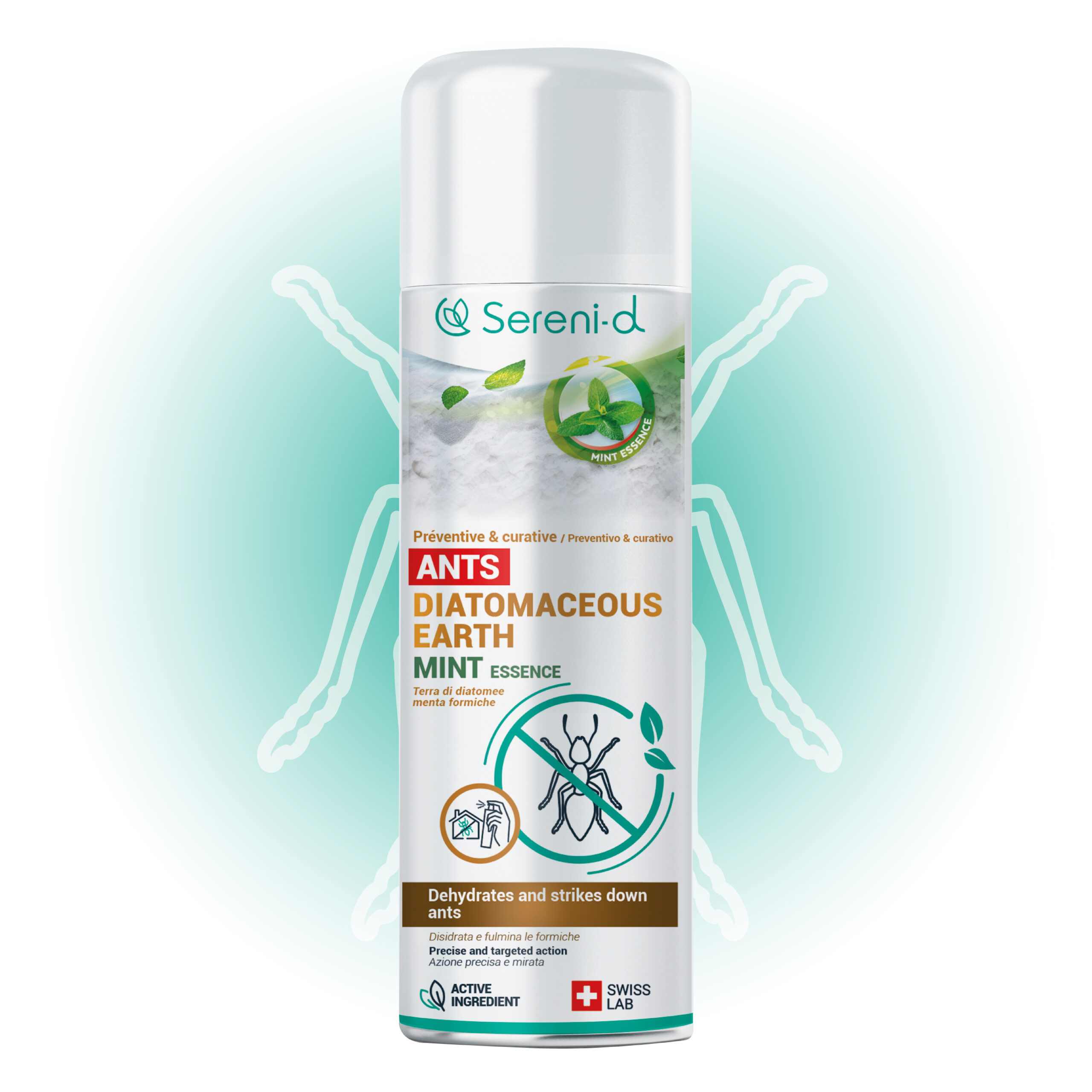Although most ants found in France are harmless, some species can sting and cause itching, swelling and even allergic reactions. How can you recognise these stings? What should you do to treat them? Here are our recommendations.
Key information
➡️ Not all ants sting: only a few species, such as red ants and fire ants, inject formic acid, which causes burning.
➡️An ant sting usually causes redness, a small bump and mild itching, which is not serious.
➡️If you are stung: clean and disinfect the area, then apply a soothing cream or natural remedy (vinegar, bicarbonate of soda, aloe vera).
➡️Avoid scratching to prevent infection, and consult a doctor if the reaction worsens (fever, swelling, breathing difficulties).
➡️To prevent bites, wear protective clothing, avoid anthills and keep your home clean.
Which ants sting?
Of the approximately 200 species recorded in France, only a handful can sting or bite, and only when they feel threatened. For example, the small black ants often found in homes are harmless..
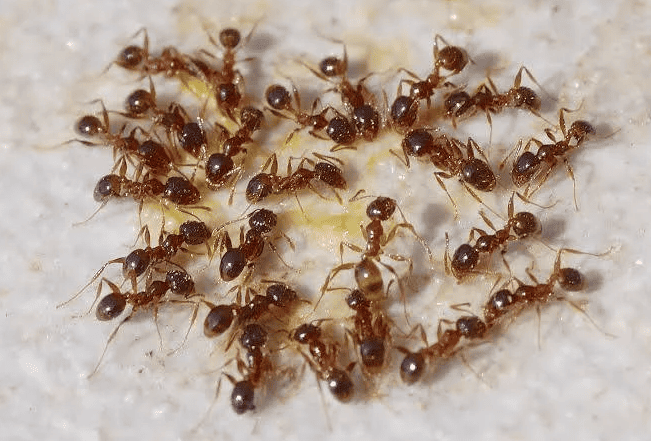
The red ant (Myrmica rubra)
The nightmare of hikers and gardeners! Very common in temperate regions, the red ant lives in grassy, damp areas such as forests. Its bite is painful, comparable to a mild burn, and often causes a small red blister that itches for several hours. When it bites, it injects a formic acid-based venom that causes the burning sensation.
What does the red ant look like?
- Where to find it: lawns, gardens, damp meadows, under stones or tree stumps.
- Size: approximately 4 to 6 mm.
- Colour: brownish red, sometimes coppery.
- Appearance: slender body with bent antennae and a visible sting at the rear.
- Behaviour: very mobile, aggressive when its nest is disturbed.
The fire ant (Solenopsis invicta)
Native to South America, this invasive species is still rare in France, but it is now present in Southern Europe. Global warming and maritime transport are facilitating its spread.
Be careful, it is extremely aggressive, its multiple stings inject a powerful venom causing redness, blisters and sometimes severe allergic reactions. Its stings are very painful for humans.
A single colony can contain several hundred thousand individuals, making them a real nuisance once they have settled in.
What does the fire ant look like?
- Size: 2 to 6 mm, depending on caste (workers or queens).
- Colour: reddish brown
- Appearance: imposing head, sting.
- Behaviour: extremely aggressive, attacks in groups: several successive stings.
- Where to find it: dry soil, sunny areas, lawns, sometimes near dwellings.
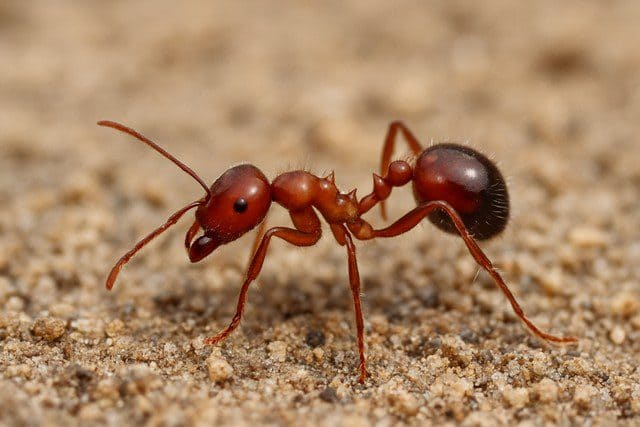

The electric ant (Wasmannia auropunctata)
Less well known than the red ant, the electric ant is nevertheless one of the most invasive and painful species in the world. Native to South America, it has spread to several tropical and subtropical regions, including New Caledonia, Guadeloupe and French Guiana. It was first spotted in France in Toulon in 2022.
Its sting is sharp and burning, comparable to an electric shock lasting 2-3 hours, hence its nickname, the electric ant. It threatens not only local biodiversity, but also human dwellings, as it settles in electrical sockets, household appliances and wooden structures, sometimes causing short circuits.
What does the electric ant look like?
- Size: approximately 1.5 mm for workers and 4.5 mm for queens
- Colour: brown to orange body
- Where to find it: inhabited areas, sources of heat.
Good to know: If you spot red, fire or electric ants, notify the authorities immediately so that the infestation can be dealt with.
Do black garden ants bite?
This type of ant, which is very common in our homes and on our patios, does not actually bite; it bites with its mandibles, without injecting venom, and only if it feels threatened. The sensation is brief and not serious, even for sensitive skin.
Why do ants bite?
Ant bites never happen by chance: these insects do not seek to attack humans, but react when they feel threatened or when their colony is disturbed..
A defensive reaction
Ants sting mainly to protect their nest, their eggs or their queen. When they sense a vibration or an intrusion into their territory, they send a chemical warning signal to their fellow ants. Within seconds, dozens of workers can mobilise to defend the anthill..
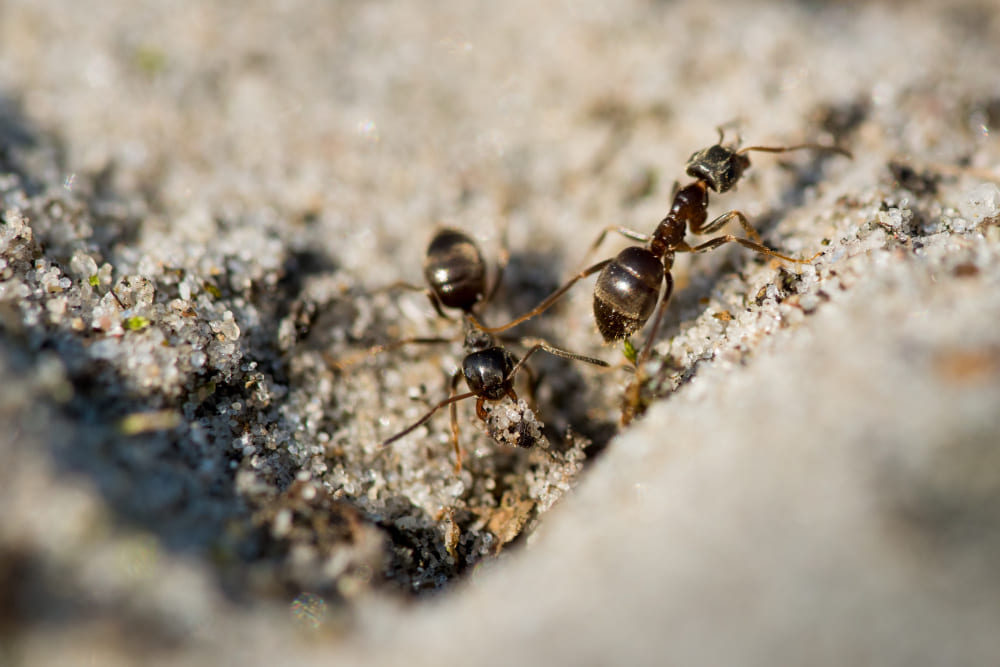

Frequent risk situations
Stings often occur accidentally, in everyday situations:
- Walking barefoot in the grass or on dry ground in summer, without seeing a hidden anthill.
- Stepping on a nest hidden under leaves, stones or grass.
- Sitting or picnicking on infested ground: ants, attracted by crumbs, climb onto skin or clothing.
- Gardening without gloves, handling soil, pots or wood stored near a colony.
How can you recognise an ant bite?
Although their intensity varies depending on the species, most ant bites cause localised redness and a slight burning sensation.
In practice, the ant will first bite you with its mandibles and then, in the case of certain species, inject you with venom through a sting..
Visible signs on the skin
- A small red blister or slightly raised spot, often on the ankles, feet, legs or hands.
- A darker central spot or thin scab in the middle of the bitten area.
- Slight inflammation around the lesion (circular mark), accompanied by itching.
- Sometimes, clusters of spots appear if several ants have bitten at the same time.

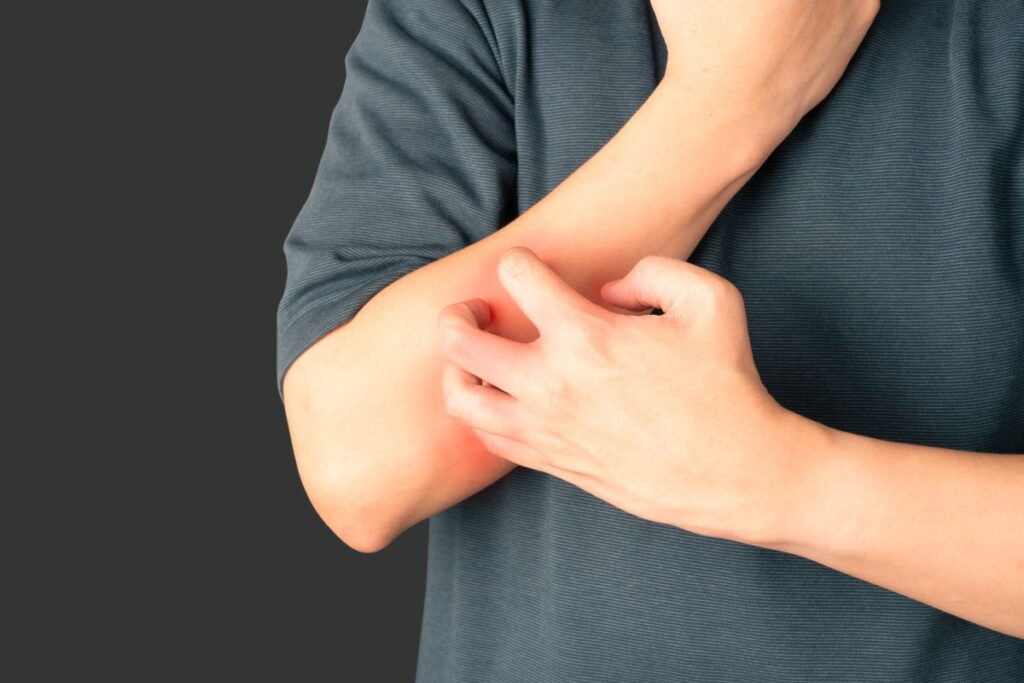
Sensations following a sting
- A quick stinging or burning sensation upon contact with the insect.
- Itching in the hours that follow.
- In some cases, swelling or slight blistering that persists for 24 to 48 hours.
- Rarely, a throbbing pain or a feeling of local heat.
However, there is no need to worry, as these reactions are generally localised and mild, except in the case of an allergic reaction.
Comparison with other insect bites
| Insect | Appearance of the bite | Pain / Sensation | Severity / Risks |
| Red ant (Myrmica rubra) | Small red blister with a white centre | Immediate burning sensation, sharp pain | Mild to moderate, may last 24 to 48 hours |
| Fire ant (Solenopsis invicta) | Button in the centre of a red area | Stinging pain, like a burn | Possible allergic reactions, rare cases of shock |
| Electric ant (Wasmannia auropunctata) | Small clusters of red spots | Feeling of an electric shock | Risk of allergy or local oedema |
| Mosquito | Isolated red button, without white dot | Mild to moderate itching | Benin, possible transmission of tropical viruses |
| Bee | Rapid swelling with visible sting | Sharp pain, single sting | Possible severe allergies (anaphylactic shock) |
| Wasp | Red, swollen button, without a sting | Immediate acute pain | Possible severe allergic reactions |
| bed bugs | Clustered punctures in a line (1 to 5 buttons) | Night-time itching | No serious allergies, but significant discomfort |
Risks and possible complications following ant bites
1. Skin infection
As with all insects, scratching too hard may break the skin and cause a minor bacterial infection.
In this case, you can disinfect the area with a mild antiseptic solution and consult a doctor if the lesion worsens.
2. Allergic reactions
Some people may have an allergic reaction to the venom (similar to that of bees, wasps or other hymenoptera).
Symptoms appear quickly after the sting:
- swelling of the face, eyelids or tongue,
- significant local oedema,
- difficulty breathing or swallowing,
- dizziness or general discomfort.
In these cases, it is a medical emergency: call 15 or 112 immediately.
Good to know: children’s thin skin reacts more strongly.
How to treat and relieve an ant bite?
Here’s what to do if you have ant bites.
1. Clean the bitten area
Wash your skin with water and mild soap, or use an antiseptic spray available from a chemist. Pat dry with a clean compress, without rubbing.
This simple step eliminates any bacteria and reduces the risk of skin infection.
2. Relieve pain and itching
Apply a soothing cream such as Apaisyl®. Be careful of toxic substances that may sometimes be present. You can find a comparison of post-bite products here.
In case of severe pain or inflammation, use a local anti-inflammatory gel or cortisone-based cream (on medical advice)..
Good to know: an ice pack (wrapped in a cloth) can help reduce pain and swelling.
In any case, avoid scratching! You risk causing a secondary infection and leaving scars. If the itching persists, you can take a mild antihistamine (ask your chemist for advice).
3. Useful natural remedies
If you prefer gentle, natural solutions to soothe ant bites, certain everyday products can be effective. These remedies relieve pain, reduce itching and promote healing without damaging the skin..
White vinegar
White vinegar neutralises formic acid, the substance responsible for the burning sensation felt after a sting.
➡️ Soak a cotton ball in white vinegar and apply it directly to the stung area for one to two minutes. Be sure to dilute it with water beforehand.


Aloe vera gel
Known for its anti-inflammatory and healing properties, pure aloe vera gel is very useful against insect bites.
➡️ Apply a small amount of gel to clean skin and allow to dry in the open air.
It instantly soothes the sensation of heat, reduces marks and promotes skin regeneration..
Baking soda
Baking soda helps to rebalance the skin’s pH and soothe irritation.
➡️ Mix one teaspoon of bicarbonate of soda with a little water to form a paste. Apply as a poultice to the affected area for 10 to 15 minutes, then rinse.
This remedy is particularly useful in cases of burning or swelling after multiple stings..

Practical tip: keep your aloe vera tube or bicarbonate mixture in the refrigerator, as the cold enhances the soothing effect on the skin.
When should you see a doctor after an ant bite?
In the vast majority of cases, ant bites are harmless and disappear on their own within a few hours or days.
However, some situations require prompt medical attention.
Seek immediate medical attention if:
- The area around the sting swells significantly or spreads rapidly.
- You experience difficulty breathing, swelling of the face or throat, or a feeling of suffocation: this may be a severe allergic reaction (such as anaphylactic shock).
- The bite causes fever, chills or increasing pain.
- The area becomes hot, red and painful several days after the bite: possible bacterial infection.
- You have been bitten several times or over a large area (e.g. trampled anthill).
➡️ Reactions may be more severe in children, people with allergies, the elderly, or those with chronic illnesses.
4 tips to avoid ant bites
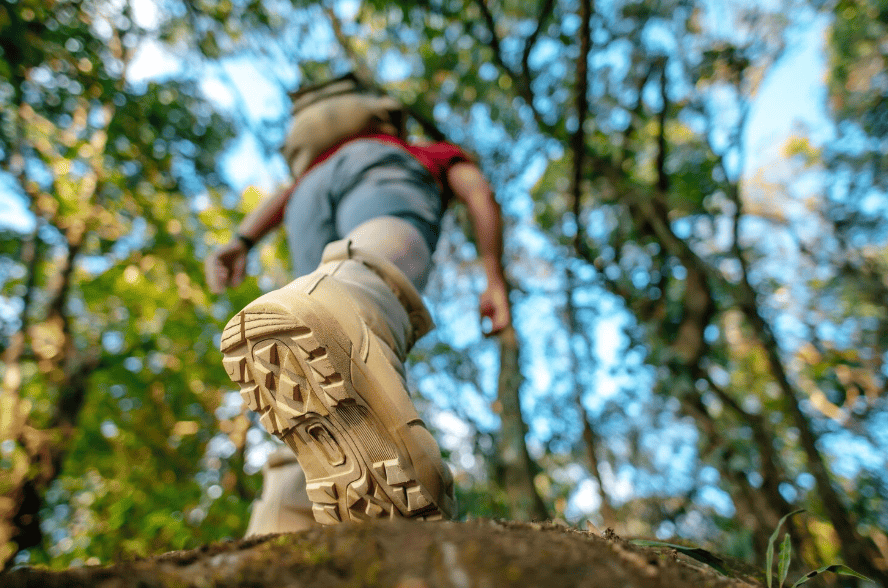
1. Protect yourself in high-risk areas
When walking, hiking or gardening:
- Wear long clothing (trousers, socks, long sleeves) to protect your legs and feet.
- Wear closed shoes and avoid walking barefoot in the grass.
2. Be careful during picnics or outdoor activities
Ants are attracted to food, sugar and crumbs.
- Be careful with children who want to stamp on anthills.
- Avoid placing your picnic directly on the ground, especially in parks or wooded areas.
- If you notice a line of ants or the entrance to a nest, move further away.


3. Use natural repellents and insecticides
To repel ants without harsh chemicals, sprinkle a little bicarbonate of soda, diatomaceous earth or white vinegar around the infested areas..
4. Clean regularly
Household ants love kitchens and damp rooms.
We therefore recommend that you:
- Clean worktops, floors and bins regularly.
- Store food in airtight containers.
- Repair any water leaks: damp also attracts these insects.

FAQ
Bite or sting: what’s the difference?
In summary: bites pinch, stings burn.
Are ant bites dangerous to your health?
They are rarely serious, except in cases of severe allergic reaction (difficulty breathing, swelling of the face). Some tropical species, such as fire ants, can cause severe reactions, but these are very rare in the UK.
Do flying ants sting?
They are generally harmless and do not sting, as they do not defend the colony. However, they may bite lightly if they feel trapped, but without injecting venom or posing any real danger.
Do ants cause spots?
In some sensitive individuals, the skin may react more strongly, with several spots clustered together or localised swelling. These marks usually disappear within 24 to 72 hours, provided that you do not scratch them and disinfect the area properly.

